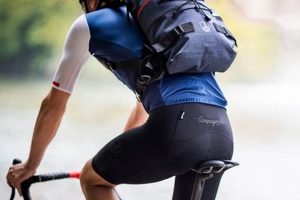Determining appropriate rucksack dimensions involves assessing torso length and intended carrying capacity. Torso length dictates the frame size necessary for comfortable weight distribution, while the volume, typically measured in liters, reflects the amount of gear the pack can accommodate. This measurement ensures a balance between carrying capability and manageable load weight.
Selecting a properly sized pack is crucial for preventing strain and injury during extended use. A well-fitted rucksack distributes weight evenly across the hips and shoulders, minimizing back pain and improving overall balance. Historically, ill-fitting packs led to discomfort and impaired performance, highlighting the importance of precise sizing in modern outdoor equipment.
This resource outlines practical methods for accurately measuring torso length and estimating the necessary pack volume based on typical trip duration and gear requirements. Subsequent sections detail how to interpret these measurements in relation to manufacturer sizing charts and provide guidance on fitting adjustments.
Guidance on Rucksack Sizing
The following recommendations facilitate the selection of a rucksack with appropriate dimensions for the user’s physical attributes and intended use.
Tip 1: Measure Torso Length Accurately: Employ a flexible measuring tape to determine the distance between the iliac crest (top of the hip bone) and the C7 vertebra (prominent bone at the base of the neck). This measurement is critical for selecting the correct frame size.
Tip 2: Consider Pack Volume in Liters: Evaluate the anticipated gear requirements for typical excursions. Shorter trips often necessitate smaller volume packs, while extended expeditions demand greater carrying capacity.
Tip 3: Consult Manufacturer Sizing Charts: Refer to the rucksack manufacturer’s sizing guidelines, which correlate torso length with specific frame sizes. These charts provide a starting point for selecting the appropriate model.
Tip 4: Prioritize Adjustability: Opt for rucksacks with adjustable shoulder straps, hip belts, and torso lengths. This allows for fine-tuning the fit and accommodating variations in load weight.
Tip 5: Load Simulation: Before committing to a purchase, simulate a typical load by filling the rucksack with representative gear. Wear the loaded pack for an extended period to assess comfort and stability.
Tip 6: Seek Expert Assistance: Consult with experienced outdoor equipment retailers who can provide personalized fitting advice and assess the suitability of different models.
Tip 7: Evaluate Hip Belt Fit: The hip belt should sit comfortably on the iliac crest and bear a significant portion of the load weight. Ensure the belt provides adequate support and does not cause chafing.
Adhering to these guidelines will significantly improve comfort and reduce the risk of injury when carrying a loaded rucksack. Proper sizing ensures efficient weight distribution and optimizes performance during outdoor activities.
The subsequent section will delve into advanced fitting techniques and address common issues encountered during rucksack use.
1. Torso Length Measurement
Torso length measurement forms a foundational element in determining appropriate rucksack dimensions. An accurate measurement dictates the frame size necessary for optimal weight distribution. Without a precise understanding of an individual’s torso length, the selected rucksack may not effectively transfer weight to the hips, resulting in shoulder strain and potential back injury. For example, a rucksack designed for a 19-inch torso worn by someone with a 16-inch torso will position the hip belt incorrectly, rendering it incapable of carrying its intended load.
Manufacturers provide sizing charts that correlate torso length ranges with specific frame sizes. These charts serve as a guide for selecting the appropriate rucksack. However, the effectiveness of these charts relies entirely on the accuracy of the initial torso length measurement. Discrepancies in this measurement lead to inaccurate size selection, negating the benefits of the sizing chart. Moreover, while pack volume (measured in liters) determines carrying capacity, it is the frame size, determined by torso length, that dictates how comfortably and efficiently that volume can be transported.
In summary, torso length measurement is not merely a preliminary step but an integral component of the rucksack sizing process. Its accuracy directly influences the functionality and comfort of the rucksack. Ignoring or underestimating the importance of precise torso length measurement compromises the effectiveness of all subsequent sizing adjustments and undermines the overall purpose of selecting a properly fitting rucksack.
2. Volume (Liters) Assessment
Rucksack volume, expressed in liters, directly dictates its carrying capacity and, subsequently, influences the appropriate size selection. The quantity of gear required for a given activity establishes a minimum volume requirement. Attempting to fit an excessive volume of equipment into a pack designed for smaller loads can compromise comfort, damage the rucksack, and negatively impact stability. Conversely, utilizing a rucksack with excessive volume for minimal gear results in inefficient weight distribution and unnecessary bulk. Therefore, a meticulous assessment of gear volume serves as a critical determinant of the optimal rucksack size. For instance, a day hike necessitating water, snacks, and minimal layers might only require a 20-30 liter pack, while a multi-day backpacking trip demanding a tent, sleeping bag, cooking equipment, and ample provisions would necessitate a pack in the 50-75 liter range or larger.
Determining the required volume involves a systematic evaluation of all items to be carried. This process requires considering not only the physical dimensions of each item but also their compressibility. For example, a down sleeping bag is significantly more compressible than a synthetic fill equivalent, allowing for a smaller volume pack. Furthermore, efficient packing techniques, such as utilizing compression sacks and strategically distributing weight, can maximize the use of available volume and potentially reduce the required pack size. An individual planning a week-long wilderness trek who underestimates the volume required for food and water may be forced to either leave essential items behind or overstuff the pack, leading to discomfort and potential equipment failure. Conversely, an overestimation could lead to using a rucksack that is too large and cumbersome for the load being carried.
In conclusion, volume assessment is not merely an estimation of gear capacity but an integral part of the overall rucksack sizing process. Precise volume determination, coupled with efficient packing strategies, ensures the selection of a rucksack that comfortably accommodates the necessary equipment without compromising comfort or stability. Challenges in volume assessment often arise from underestimating the cumulative space required for seemingly small items. Careful consideration and experience are therefore vital to effectively determine the most appropriate pack volume for any given activity. This volume, alongside torso length, collectively defines “how to find the size of your backpack.”
3. Frame Size Correlation
Frame size correlation serves as a pivotal step in determining appropriate rucksack dimensions. It represents the direct link between measured torso length and the manufacturer’s sizing specifications. Without accurately correlating torso length to the appropriate frame size, the rucksack’s load-bearing capabilities are compromised, potentially leading to discomfort and injury. Rucksack manufacturers typically provide sizing charts that detail the relationship between torso length ranges (e.g., 16-18 inches) and corresponding frame sizes (e.g., Small, Medium, Large). Frame size correlation dictates the vertical distance between the shoulder straps and the hip belt, a crucial element for effective weight transfer.
Consider a hiker with a torso length of 18.5 inches. Consulting a typical manufacturer’s chart might suggest a “Medium” frame size. However, variations exist across brands. Some manufacturers may classify 18.5 inches as bordering between a “Medium” and “Large” size. Therefore, a trial fitting with both sizes is recommended to ascertain which frame best aligns with the individual’s body contours. A frame that is too small concentrates weight on the shoulders, while one that is too large positions the hip belt improperly, preventing effective weight transfer to the hips. Proper frame size ensures the rucksack’s structural components align with the user’s anatomy, enabling efficient load distribution. Factors such as pack style (internal frame vs. external frame) also influence frame size correlation, requiring careful consideration of the rucksack’s design in relation to the sizing chart.
In summary, frame size correlation is an indispensable process for achieving optimal rucksack fit. It bridges the gap between individual body measurements and manufacturer sizing standards. The process demands careful attention to both torso length and brand-specific sizing charts, emphasizing the importance of a thorough fitting process to ensure correct size selection. Failure to accurately correlate frame size undermines the overall purpose of sizing, compromising comfort, stability, and the potential for injury. Thus it is an inseparable component of “how to find the size of your backpack.”
4. Hip Belt Placement
Effective hip belt placement is inextricably linked to determining appropriate rucksack dimensions. Its primary function is to transfer the majority of the load weight from the shoulders to the hips, distributing it across the skeletal structure and reducing strain on the back. Improper placement negates this advantage, concentrating weight on the shoulders and potentially leading to discomfort, fatigue, and long-term musculoskeletal issues. Therefore, achieving optimal hip belt placement is not merely a matter of comfort; it is a critical element in ensuring the rucksack functions as designed.
The ideal position involves centering the hip belt over the iliac crest, the uppermost point of the hip bones. The belt should be snug enough to prevent slippage but not so tight as to cause discomfort or restrict movement. Achieving this requires a rucksack with a frame size that accurately matches the torso length, as the vertical distance between the shoulder straps and hip belt is predetermined by the frame. For instance, if a rucksack is too large, the hip belt will sit too low, transferring weight to the upper thighs instead of the hips. Conversely, if the rucksack is too small, the hip belt will sit too high, potentially impacting the rib cage and failing to provide adequate support. A practical example is a long-distance hiker using an improperly sized pack; the resulting shoulder strain from poor hip belt placement can significantly reduce endurance and increase the risk of injury. Understanding hip belt placement, and thereby its impact on “how to find the size of your backpack”, is a crucial step in assessing rucksack size and fit.
In conclusion, hip belt placement is not a secondary consideration, but a fundamental aspect of proper rucksack sizing. Achieving optimal placement depends on the initial torso length measurement and the subsequent frame size selection. The process of “how to find the size of your backpack” ultimately culminates in achieving a fit that allows the hip belt to perform its intended function: efficiently transferring weight to the hips and preventing undue strain. Challenges in achieving correct placement often stem from inaccurate torso measurements or variations in manufacturer sizing standards. Therefore, a meticulous approach to both measurement and fitting is essential for realizing the ergonomic benefits of a properly sized rucksack.
5. Load Simulation Importance
Load simulation constitutes a critical, often overlooked, component in determining appropriate rucksack dimensions. While torso length measurement, volume assessment, frame size correlation, and hip belt placement offer essential data points, these factors represent theoretical assessments. Load simulation provides a practical validation of the sizing choices, exposing discrepancies that may not be apparent during static fitting. This process involves loading the rucksack with weight representative of typical use-case scenarios and then wearing the pack for an extended period, ideally simulating actual activity conditions. The absence of load simulation can result in the selection of a rucksack that feels comfortable when empty but proves unsuitable under real-world conditions, undermining all prior sizing efforts.
A common scenario involves a hiker meticulously measuring their torso length and selecting a rucksack based on the manufacturers sizing chart. However, upon loading the pack with typical gear (water, food, clothing, shelter), the individual experiences pressure points on their shoulders or lower back. These issues may stem from inadequate frame support, insufficient padding, or improperly positioned load lifter straps, all of which become evident only under load. Another practical application lies in adjusting pack features. Load simulation permits iterative adjustments to strap lengths and hip belt positioning to refine weight distribution. This real-time tuning optimizes comfort and minimizes strain before embarking on an actual trip. Moreover, varying load weights during simulation reveals the pack’s adaptability and informs packing strategies to maintain a balanced and comfortable carry. Thus, load simulation offers critical insight into how “how to find the size of your backpack” is best achieved.
In summary, load simulation transforms theoretical sizing into practical validation, exposing unforeseen comfort and stability issues. It serves as an essential feedback loop, allowing for iterative adjustments to rucksack features and packing strategies. Challenges may include replicating realistic conditions or accurately estimating typical load weights. However, the benefits of load simulation in preventing discomfort, minimizing injury risk, and optimizing rucksack performance far outweigh these challenges. Ultimately, skipping this step diminishes the efficacy of all other sizing procedures, compromising the overall objective of finding a properly fitting and functional rucksack. Load simulation serves as a final test in “how to find the size of your backpack”.
Frequently Asked Questions
The following section addresses common inquiries and clarifies frequently encountered misconceptions regarding the selection of correctly sized rucksacks.
Question 1: Is rucksack volume directly proportional to torso length?
No. Volume, measured in liters, indicates carrying capacity, while torso length dictates frame size. While both factors influence rucksack selection, they are independent variables. A shorter torso may necessitate a smaller frame, but the required volume depends on the anticipated gear load, irrespective of torso length.
Question 2: Can the same rucksack size be used for both summer and winter backpacking?
Potentially, but it is unlikely. Winter backpacking typically requires a larger volume pack due to the increased bulk of cold-weather gear, such as insulated clothing, a warmer sleeping bag, and potentially snowshoes or skis. A summer pack may prove insufficient for winter conditions.
Question 3: How does hip belt size relate to frame size?
While frame size is determined by torso length, hip belt size is often independent and adjustable. A correctly sized frame ensures the hip belt is positioned correctly on the iliac crest, but the circumference of the hip belt must also fit the individual’s waist size. Many rucksacks offer interchangeable hip belts for greater customization.
Question 4: Are women’s-specific rucksacks simply smaller versions of men’s rucksacks?
No. Women’s-specific rucksacks are designed to accommodate the anatomical differences between male and female torsos. This typically involves shorter torso lengths, narrower shoulder straps, and contoured hip belts. These design features enhance comfort and improve load distribution for female users.
Question 5: Can rucksack volume be accurately estimated without measuring individual gear items?
While a rough estimate is possible based on experience, accurate volume determination requires considering the size and compressibility of each gear item. Utilizing packing techniques and compression sacks can optimize space, but a precise assessment necessitates evaluating individual gear dimensions.
Question 6: Does rucksack brand influence the correlation between torso length and frame size?
Yes. Manufacturers employ varying sizing standards. A torso length that corresponds to a “Medium” size in one brand may be a “Large” in another. Always consult the specific manufacturer’s sizing chart and, ideally, conduct a fitting to ensure optimal size selection.
Accurate rucksack sizing is a multi-faceted process, demanding careful consideration of multiple factors and a thorough understanding of individual needs. Failure to address these aspects can result in discomfort and diminished performance. The above discussion should provide clarification to the complexities of, and thereby better inform, “how to find the size of your backpack”.
The following section will discuss advanced fitting techniques.
Conclusion
The preceding discussion underscored the multifaceted nature of rucksack sizing. It emphasized the crucial role of precise torso length measurement, diligent volume assessment, accurate frame size correlation, optimal hip belt placement, and the indispensable value of load simulation. Each element contributes significantly to ensuring a properly fitting and functional rucksack, minimizing discomfort and maximizing performance under diverse conditions.
Therefore, a systematic approach is necessary. Diligent application of the principles presented herein will contribute significantly to an informed decision, ensuring a rucksack that supports the individual’s endeavors effectively and sustainably. The principles of “how to find the size of your backpack” are not merely procedural, but a commitment to physical well-being and optimized performance in the outdoors.







